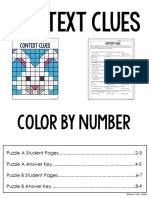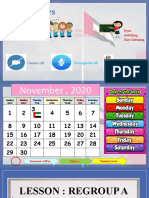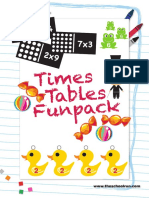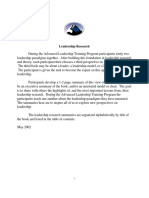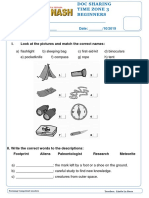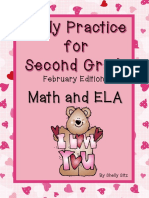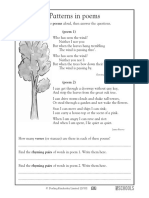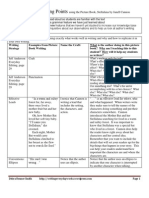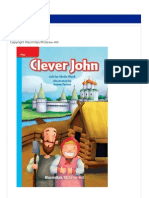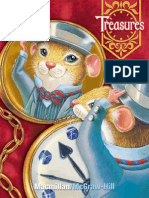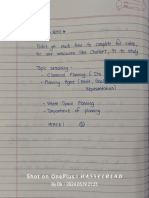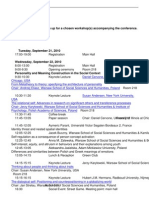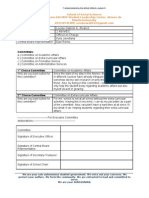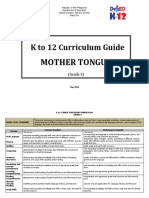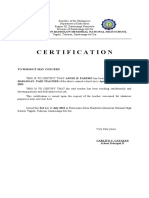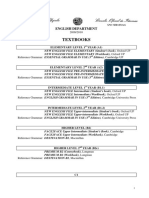Essentials: Week by Week
Essentials: Week by Week
Uploaded by
Hirenkumar ShahCopyright:
Available Formats
Essentials: Week by Week
Essentials: Week by Week
Uploaded by
Hirenkumar ShahOriginal Description:
Original Title
Copyright
Available Formats
Share this document
Did you find this document useful?
Is this content inappropriate?
Copyright:
Available Formats
Essentials: Week by Week
Essentials: Week by Week
Uploaded by
Hirenkumar ShahCopyright:
Available Formats
75
G
r
a
d
e
2
MATHEMATICS
Essentials
Week
by
Week
WEEK
1 7
Seeing Math
Investigations
1
2
3
4
Lets Write
Write a note to explain to your teacher
how you and your partner played Race
to a Dollar.
$ $ $ $
If each face of a cube is worth five points,
how much is one cube worth?
How much would two cubes be worth?
three cubes = ___ four cubes = ___
How do you know?
What Do You Think?
The students wanted to play
ball. Each team needs eight players.
There are 11 boys and 13 girls
in the class.
How many teams can be
made from the students
in the class?
Write about your solution.
(1.05)
(3.02)
(1.05)
(1.03)
1. Fold a square along the diagonal. Cut
on the fold. What shapes do you have?
2. Take one triangle. Fold the top
down. Cut along the fold. What two
shapes do you have?
3. Fold the other large triangle in half.
Cut. What do you have?
4. Can you make the square?
Patterns, Patterns, Patterns
Find the error in the patterns.
1. AABCAABCAABCCAABC
2. 56, 54, 52, 50, 48, 47, 44, 42
(5.01)
Have children look through magazines to
find pictures of shapes composed of cubes,
rectangular prisms, cylinders, cones, and
spheres. Cut out the pictures and glue on a
recording sheet as a class. Identify the shapes
that make the larger figure. These may be
displayed on a bulletin board.
(3.01)
76
(1.01f )
Race to a Dollar
Directions: Each student needs a gameboard. Students take turns rolling a die and collecting
pennies. Ten pennies will trade for a dime. The first player to win ten dimes (and thus has the
value of a dollar) is the winner.
Dimes Pennies
(1.01a, f)
77
Keeping Skills Sharp
Solve this!
1 -
=
+ +
2
3
4
1. 14 - 9 = ___ 2. 50 - 10 = ___
3. 17 - 8 = _____ 4. 90 - 40 = _____
5. Whats missing?
6. December is the 12th month. March is the ___
month.
7. Is 76 closer to 70 or 80?
70 71 72 73 74 75 76 77 78 79 80
8. Sara drew eleven stars. Darius drew four stars.
How many more did Sara draw than Darius?
How many different ways can twelve counters be placed in each part of a
three circle snowman, with at least one counter in each circle?
Find a way to record your answers.
81 82 84
92 93
(1.05)
78
G
r
a
de
2
To the Teacher
WEEK
Mental Math Keeping Skills Sharp
Directions to Students: Number your paper from
1 to 10. Write your answers as the questions are called
out. Each question will be repeated only once.
Games of the Week: Race To A Dollar
Children can use real money, plastic money or paper coins (see the Blackline Masters). This
game focuses on place value and coin recognition (penny, dime).
Investigations:
Another possibility is a shape book with each geometric shape having its own chapter or a series
of shape books. Students can add to the collectionas the year progresses.
Solve This:
Students use unifix cubes, two color counters, beans, etc. One way students could record their
answers is with number sentences (3 + 3 + 6; 9 + 1 + 2; 2 + 2 + 8, etc.).
5 73, 83
40 3rd
9 80
50 7
Write the number that is ten less than: Write the sum or difference:
1. 17 5. 5 + 8
2. 48 6. 9 + 6
3. 30 7. 12 - 3
4. 87 8. 9 + 8
9. 15 - 6
10. 14 - 7
1 7
79
G
r
a
d
e
2
MATHEMATICS
Essentials
Week
by
Week
WEEK
1 8
Seeing Math
Circle the symmetric figure.
Investigations
Given these number sentences, what number would
you add to get the indicated result?
3 + ___ = 20 11 - ___ = 2
5 + ___ = 13 15 + ___ = 41
18 - ___ = 7 27 - ___ = 3
___ - 5 = 6 19 + ___ = 31
4 + ___ = 8 14 - ___ = 2
Arrange your numbers in a systematic way. (For
example, chart, table, pattern, etc.)
1
2
3
4
Lets Write
$ $ $ $
Ida has three coins. The total amount is 21.
What coins could she have?
Bill has four coins. The total amount is 25.
What coins could he have?
What Do You Think?
There are some goats, some ducks, some pigs
and some chickens in the farmyard. If you go
out, you can see 22 legs. What animals might
you see?
Patterns, Patterns, Patterns
What is the rule?
(3.01)
(1.04)
(1.01a)
(1.05)
(5.01)
Write a story about a triangle who
wanted to become a star.
1
2
3
4
5
(3.03a)
80
Tangram Search
Materials: Game cards; one set of
tangrams* per two players.
Directions: Place cards face down and draw
a card. Without touching the
tangrams, decide which three or
four pieces could fill the shape.
Pick up the pieces and try. If
your solution works, keep the
card. If not, put the card on the
bottom of the stack. The next
player takes a turn.
The winner is the person with
the most cards.
(3.01)
*Note: These shapes are based on a 10 cm square tangram set.
81
82
83
Keeping Skills Sharp
Solve this!
1 -
=
+ +
2
3
4
1. 17 + = 20 2. 13 + = 18
3. - 9 = 6 4. - 3 = 9
5. Whats missing?
6. What shape is a soup can?
7. Whats the number?
8. Tom fished for five hours. He caught ten fish and
put them in a bucket. When he looked in the bucket, there were
only six fish. How many fish were missing?
At the ice cream store you can buy chocolate, vanilla, and strawberry ice
cream. The store has two kinds of cones, sugar and regular.
How many different cones with one
scoop could you buy?
Show your answer in words, numbers or pictures.
12
22 23 24
(1.05)
84
G
r
a
de
2
To the Teacher
WEEK
Mental Math Keeping Skills Sharp
Directions to Students: Number your paper from
1 to 10. Write your answers as the questions are called
out. Each question will be repeated only once.
1 8
Lets Write:
The Greedy Triangle by Marilyn Burns would be a good book to read to the class. Before the
children write, draw a five-pointed star and talk about the geometric shapes.
Investigations:
Students should be encouraged to write number sentences with blanks or symbols and then share
them with their classmates.
Assessment:
Students have now completed half of the school year. As you reflect on what the children have
learned and what they need to learn, remember to set high expectations for your children and
refer to the Standard Course of Study Goals and Objectives to help set those high expectations.
Game of the Week
Tangram Search: If you do not have plastic tangrams, go to the Blackline Masters section for a
copy. Copy on stiff paper or tagboard and cut apart.
Is this an even or an odd number? Write the sum or difference:
1. 37 5. 13 - 7
2. 19 6. 11 - 8
3. 74 7. 7 + 8
4. 61 8. 12 - 4
9. 7 + 4
10. 8 + 5
3 21, 33
5 cylinder
15 215
12 4
85
G
r
a
d
e
2
MATHEMATICS
Essentials
Week
by
Week
WEEK
1 9
Seeing Math
Investigations
1
2
3
4
Lets Write
.
$ $ $ $
What does a school lunch cost?
Make a display to show how you might pay
for lunch. How many different ways could
you pay the lunchroom worker?
With a partner find a way to make a display
of all the possible ways.
What Do You Think?
Patterns, Patterns, Patterns
How many snowmen? 1 2 3 4 5 6
How many snowballs? 3 6 9
(3.01)
(1.01a)
Write a story about how
many eyes, noses and
buttons five snowmen
like this need.
(1.05)
What do my blocks look like?
Draw what I describe:
1. Three groups of Unifix cubes
with two cubes in each group.
2, The cubes are side by side but
the groups are separate.
3. The first cube in each group is
upside down.
(3.01)
(1.05)
(5.01)
Use old greeting cards or pieces of wall paper to
create puzzles.
1. Take a card.
2. Cut it into five
or six sections.
3. See if you can put it back
together.
4. Give it to a friend and see if
he/she can put it together.
Carrie is getting ready for school.
She has a blue shirt and a green shirt. She has
white pants, blue pants and brown pants.
How many different ways could Carrie wear
her clothes to make different outfits?
If her aunt gives her a red sweater, how would
your answer change?
In pairs or small groups allow students to
answer the questions.
86
Panther Nim
(3.01)
Materials: Pattern blocks (trapezoids, hexagons, triangles, and blue parallelograms) and a
game board for two players
Directions: Players take turns placing a pattern block on the game board. The player who places
the final block wins!
87
Keeping Skills Sharp
Solve this!
1 -
=
+ +
2
3
4
1. 46 - 10 = ____ 2. 37 + 10 = ___
3. 640 4. 380
+ 10 - 10
5. Whats missing?
6. June, July, August, September, _________
7. In 493, what is the value of the 9?
8. If Kendall has seven dimes, can he buy a toy car for 66?
The sun comes up at six oclock in the morning and sets at seven thirty in the
evening.
If the sun is shining all day, how many hours of sunshine will there be?
How did you solve the problem?
If there are 14 hours of sunshine in one day
when could sunrise and sunset be?
Is there more than one answer?
52
61
(2.02)
88
G
r
a
de
2
To the Teacher
WEEK
Mental Math Keeping Skills Sharp
Directions to Students: Number your paper from
1 to 10. Write your answers as the questions are called
out. Each question will be repeated only once.
1 9
Write the sum: Write the difference:
1. 4 + 6 5. 10 - 4
2. 4 + 5 6. 7 - 3
3. 8 + 5 7. 10 - 2
4. 5 + 6 8. 140 - 5
9. 120 - 3
10. 9 - 3
36 54, 63
47 October
650 90/9 tens
370 yes
Investigations:
Making and solving puzzles of this type provides good practice in exercising spatial sense.
What Do You Think?
The solution to this type of problem is greatly facilitated with the addition of colored markers or
manipulatives.
Solve This:
Student clock models will prove very helpful here.
89
G
r
a
d
e
2
MATHEMATICS
Essentials
Week
by
Week
WEEK
2 0
Seeing Math
Show each drawing briefly. Have students draw
from memory.
A.
Show once
more and allow
them to adjust
their drawings.
B. What did you
see? (Ask
several
students.).
Investigations
1
2
3
4
Lets Write
Look at this months calendar. Write five
things you know about it.
$ $ $ $
Jack bought a piece of candy for 52.
He gave the clerk 100.
How much money
will he get back?
How do you know?
What Do You Think?
Patterns, Patterns, Patterns
(Review of calendar)
(3.01)
(1.01a)
(5.01)
(4.01)
If the tennis courts are open
at four oclock and the bears
play 4 one-hour games, will
they be finished before Mrs.
Bear calls them for dinner at
seven oclock?
Explain your answer.
What shape comes next? How do you know?
(2.02)
How many drops of water can you get
on the head of a penny? How many drops of
water can you get on the tail of a penny?
What rules need to be established for the
experiment?
Try a nickel, dime and a quarter.
Collect, compare and display data with a
pictograph. What symbol will you use?
What unit(s) could your symbol represent?
90
Materials: Paper clips for the spinners, pencils and gameboard.
Two players: Rod and Steven
Directions: Each players spins one spinner and the two results are added. If the sum is even,
Steven records it, if the sum is odd the number goes to Rod.
First player to fill all the blanks is the winner.
4
5
7
8
6
9
10
1
1
1
2
1 3
1
5
1
4
Odd Rod
Odds and Evens
Even Steven
(1.06)
91
Keeping Skills Sharp
Solve this!
1 -
=
+ +
2
3
4
Solve the riddle.
Four famous presidents are on the penny, nickel, dime and quarter. The four coins are in a row.
Use these clues to put the coins in the correct order:
1.The coin with the first president of the United States is last.
2.The two presidents with pony tails are next to each other.
3.The Civil War president is facing all three of the other presidents.
What order are the coins in?
Now write a riddle using one penny, one nickel, one dime and one quarter.
Let a friend read your riddle and solve it.
(1.01a)
1. = _____ 2. = _____
3. = _____ 4. = _____
5. 5, 10, 15,_____
6. How much more money do you need to make
$1.00?
7. In 387 what is the value of the 3?
8. Mrs. Lee has 25 students. Fourteen students
are girls. How many students are boys?
92
G
r
a
de
2
To the Teacher
WEEK
Mental Math Keeping Skills Sharp
Directions to Students: Number your paper from
1 to 10. Write your answers as the questions are called
out. Each question will be repeated only once.
2 0
Money, Money, Money:
Children need many concrete experiences with money.
Objective 2.15: Solve problems using money. Estimate cost and make change using coins up to
$1. These are skills that children develop over time. Children can count up to determine
change. For example to count from 32 to $1,children could count to 35 and then count by 5s or
10s to get to 100. As they count, children can use coins to keep track of the amount.
Solve This:
You may want to model the process of writing a riddle before the students write it individually.
What Do You Think?
Students need many opportunities to explore even and odd numbers. Using objects, students
can discover that when objects are paired even numbers always have a partner. Students may
also discover that even numbers can always be divided into two equal groups. Exploration of
even/odd numbers is important for second graders.
Write the sum:
1. 40 + 10 5. 80 + 20
2. 25 + 10 6. 10 + 70
3. 43 + 10 7. 15 + 10
4. 25 + 20 8. 19 + 20
9. 35 + 20
10. 50 + 30
5 20
1 44
25 300 or
3 hundreds
10 11 boys
You might also like
- Context Clues: Color by NumberDocument10 pagesContext Clues: Color by NumberJasmine OwensNo ratings yet
- Story Horse RiderDocument8 pagesStory Horse RiderAlenJonotaCaldeoNo ratings yet
- Alg1 02 Student JournalDocument31 pagesAlg1 02 Student JournalalexNo ratings yet
- Close Reading Companions Unit 5Document28 pagesClose Reading Companions Unit 5api-5037340810% (1)
- Dogzilla Reading ComprehensionDocument6 pagesDogzilla Reading ComprehensionLauren WarrenNo ratings yet
- Magic School Bus Video QuestionsDocument1 pageMagic School Bus Video Questionsapi-254428474No ratings yet
- Methods of Teaching 1. Methodological Classification of English Sounds. Ways of Introducing New SoundsDocument28 pagesMethods of Teaching 1. Methodological Classification of English Sounds. Ways of Introducing New SoundsExclusive Evgesha100% (1)
- Essentials: Week by WeekDocument16 pagesEssentials: Week by WeekHirenkumar ShahNo ratings yet
- Essentials: Week by WeekDocument16 pagesEssentials: Week by WeekHirenkumar ShahNo ratings yet
- Essentials: Week by WeekDocument19 pagesEssentials: Week by WeekHirenkumar ShahNo ratings yet
- Essentials: Week by WeekDocument20 pagesEssentials: Week by WeekHirenkumar ShahNo ratings yet
- Essentials: Week by WeekDocument18 pagesEssentials: Week by WeekHirenkumar ShahNo ratings yet
- Essentials: Week by WeekDocument16 pagesEssentials: Week by WeekHirenkumar ShahNo ratings yet
- Essentials: Week by WeekDocument19 pagesEssentials: Week by WeekHirenkumar ShahNo ratings yet
- Essentials: Week by WeekDocument16 pagesEssentials: Week by WeekluckiemanNo ratings yet
- g2 m3 Full ModuleNew York State Common Core Mathematics Curriculum For Grade 2Document283 pagesg2 m3 Full ModuleNew York State Common Core Mathematics Curriculum For Grade 2ThePoliticalHatNo ratings yet
- LKGRP3 37to150Document115 pagesLKGRP3 37to150api-3697490100% (2)
- Proplem SolvingDocument10 pagesProplem Solvingapi-345837027No ratings yet
- 0955-5 PRJ Beg Se-BDocument130 pages0955-5 PRJ Beg Se-BGwin ColemanNo ratings yet
- Memory Owl Lesson Plan Booklet PRINTDocument4 pagesMemory Owl Lesson Plan Booklet PRINTCarole Ly PiccinNo ratings yet
- Degree of Familiarity: Teacher Note Answer KeyDocument6 pagesDegree of Familiarity: Teacher Note Answer KeyfairfurNo ratings yet
- Regroup A Ten As OnesDocument8 pagesRegroup A Ten As Onesapi-345837027No ratings yet
- RSFTSSCRDocument104 pagesRSFTSSCRPanca Saskya AmandaNo ratings yet
- Times Tables FunpackDocument54 pagesTimes Tables FunpackLígia PastorNo ratings yet
- Libro1 PDFDocument230 pagesLibro1 PDFIván ChamorroNo ratings yet
- Pie Corbett Magic Bed ActivityDocument1 pagePie Corbett Magic Bed Activityapi-1970091540% (1)
- Book ReportsDocument99 pagesBook ReportsbudimahNo ratings yet
- Student's Names: - Grade: 3 Section: - Date: - /10/2019Document3 pagesStudent's Names: - Grade: 3 Section: - Date: - /10/2019Beto Urbano LimaNo ratings yet
- Florida Ready Test 1 PDFDocument75 pagesFlorida Ready Test 1 PDFQuetzalie33% (3)
- February Daily Practice PreviewDocument5 pagesFebruary Daily Practice PreviewjainNo ratings yet
- EOG Math VocabularyDocument3 pagesEOG Math VocabularyshannonchildressNo ratings yet
- The CarpDocument40 pagesThe Carpyoumna hamandi100% (1)
- Using Halves STG 5 and 6Document2 pagesUsing Halves STG 5 and 6api-282689395No ratings yet
- Vocabulary Bank: Means of TransportDocument28 pagesVocabulary Bank: Means of TransportAla ProductionNo ratings yet
- Subtracting Numbers: Learning OutcomesDocument8 pagesSubtracting Numbers: Learning OutcomesMarianne Claire LaguraNo ratings yet
- Vocabulary Ladders - Grade 6 - Condition of MaterialDocument6 pagesVocabulary Ladders - Grade 6 - Condition of MaterialfairfurNo ratings yet
- Building Writing Skills Words To Sentences Enhanced E-BookDocument50 pagesBuilding Writing Skills Words To Sentences Enhanced E-Bookdeniz meydanNo ratings yet
- Addition With RegroupingDocument9 pagesAddition With Regroupingapi-505626327No ratings yet
- Vocabulary Ladders - Grade 6 - Level of DifficultyDocument6 pagesVocabulary Ladders - Grade 6 - Level of DifficultyfairfurNo ratings yet
- BohoThemedScheduleCardsandLabelsClassroomDecorFreebie 1Document3 pagesBohoThemedScheduleCardsandLabelsClassroomDecorFreebie 1Marissa SchacherlNo ratings yet
- Diagnostic Gr. 6 PDFDocument85 pagesDiagnostic Gr. 6 PDFTrez Sereño GabitoNo ratings yet
- Suspense ToolkitDocument2 pagesSuspense ToolkitEddie ZhouNo ratings yet
- The 24 GameDocument1 pageThe 24 Gameapi-234287636No ratings yet
- Three Digit Addition: With RegroupingDocument11 pagesThree Digit Addition: With RegroupingmarialecortezNo ratings yet
- Bar Model TLP 3rd-5th GradeDocument18 pagesBar Model TLP 3rd-5th Gradeapi-518387243No ratings yet
- Computer Answer Key 6Document37 pagesComputer Answer Key 6Alam100% (1)
- Staar g3 2016test Read FDocument33 pagesStaar g3 2016test Read FsatishNo ratings yet
- Guide Math K 3 NSNDocument342 pagesGuide Math K 3 NSNKhalid MeqdadNo ratings yet
- Teacher Note Answer Key: Vocabulary LaddersDocument6 pagesTeacher Note Answer Key: Vocabulary LaddersfairfurNo ratings yet
- Third Grade PacingQ3Document3 pagesThird Grade PacingQ3alv6378No ratings yet
- Use The Chart To The Right To Answer Each Question. Show Your Work. Item PointsDocument4 pagesUse The Chart To The Right To Answer Each Question. Show Your Work. Item PointsririNo ratings yet
- Beginning Student Manual FinalDocument4 pagesBeginning Student Manual FinalDinesh GuptaNo ratings yet
- Scholastic News WorksheetsDocument5 pagesScholastic News Worksheetsapi-233717707No ratings yet
- gr3 MC Skillspract PDFDocument118 pagesgr3 MC Skillspract PDFAtif MuhammadNo ratings yet
- HOE Level 2 Classwork SheetsDocument10 pagesHOE Level 2 Classwork SheetsJaritza DiazNo ratings yet
- Year4independentwritingactivities PDFDocument48 pagesYear4independentwritingactivities PDFAthiNo ratings yet
- Specific Teaching Points Mentor Text StellalunaDocument6 pagesSpecific Teaching Points Mentor Text Stellalunadebrennersmith100% (4)
- Math Word Wall CardsDocument57 pagesMath Word Wall Cardsapi-281188069No ratings yet
- Harriet Tubman: Civil War Spy: Skill - Reading Comprehension NameDocument4 pagesHarriet Tubman: Civil War Spy: Skill - Reading Comprehension NameLydia SabaNo ratings yet
- K BridgesDocument306 pagesK Bridgespurple dotsNo ratings yet
- Feathers For LunchDocument34 pagesFeathers For LunchHirenkumar ShahNo ratings yet
- Jolly Good HockeyDocument20 pagesJolly Good HockeyHirenkumar Shah100% (2)
- Humpty Dumpty CompleteDocument25 pagesHumpty Dumpty CompleteSvetik RotaruNo ratings yet
- Emergency Vehicles WheelDocument2 pagesEmergency Vehicles WheelHirenkumar ShahNo ratings yet
- Wheels BusDocument2 pagesWheels BusHirenkumar ShahNo ratings yet
- Animal SensesDocument14 pagesAnimal SensesHirenkumar ShahNo ratings yet
- Clever JohnDocument20 pagesClever JohnHirenkumar Shah100% (1)
- Scholasticnews Indepth War-Iraq Brodkin12Document1 pageScholasticnews Indepth War-Iraq Brodkin12Hirenkumar ShahNo ratings yet
- G1V1 U1 T1Document37 pagesG1V1 U1 T1Hirenkumar Shah100% (3)
- Activity Book KDocument325 pagesActivity Book KManuel Antonio Lazo Velasquez100% (1)
- English Language Arts Test: Book 1Document16 pagesEnglish Language Arts Test: Book 1Lena KovalenkoNo ratings yet
- Expert Answers: A Child Psychologist Helps You Field The Tough Questions Your Students May AskDocument1 pageExpert Answers: A Child Psychologist Helps You Field The Tough Questions Your Students May AskHirenkumar ShahNo ratings yet
- Scholasticnews Indepth War-Iraq Militaryquestions PDFDocument1 pageScholasticnews Indepth War-Iraq Militaryquestions PDFHirenkumar ShahNo ratings yet
- Scholasticnews Indepth Space Space2Document1 pageScholasticnews Indepth Space Space2Hirenkumar ShahNo ratings yet
- Scholasticnews Indepth Shuttle PiecesDocument1 pageScholasticnews Indepth Shuttle PiecesHirenkumar ShahNo ratings yet
- Scholasticnews Indepth War-Iraq Expert AdviceDocument1 pageScholasticnews Indepth War-Iraq Expert AdviceHirenkumar ShahNo ratings yet
- Scholasticnews Indepth Special Olympics SpecialolympicsDocument1 pageScholasticnews Indepth Special Olympics SpecialolympicsHirenkumar ShahNo ratings yet
- Scholasticnews Indepth Space Space3Document1 pageScholasticnews Indepth Space Space3Hirenkumar ShahNo ratings yet
- Narrative Report On The School Orientation On EnrollmentDocument2 pagesNarrative Report On The School Orientation On EnrollmentWILLIAM VINCENT SORIANo ratings yet
- AI Unit 6 Notes by DK?Document12 pagesAI Unit 6 Notes by DK?aryapadvi1234No ratings yet
- PSPSP ProgramDocument4 pagesPSPSP ProgramEwa MiędzobrodzkaNo ratings yet
- Kalika PuranaDocument415 pagesKalika PuranaGsr Murthy75% (4)
- (18420206 - Management & Marketing. Challenges For The Knowledge Society) Assessing Students' Entrepreneurial Skills Needed in The Knowledge EconomyDocument14 pages(18420206 - Management & Marketing. Challenges For The Knowledge Society) Assessing Students' Entrepreneurial Skills Needed in The Knowledge EconomyUmna liaquatNo ratings yet
- History Ordinary p1 2023Document4 pagesHistory Ordinary p1 2023Rumbidzai MupfurutsaNo ratings yet
- Phenomenological Research PDFDocument5 pagesPhenomenological Research PDFrebellin100% (1)
- Bright Futures ScholarshipDocument2 pagesBright Futures Scholarshipfranklins2No ratings yet
- Post Project Evaluation: Waisuddin Sadry Sumit Sharma Mayank Babu Rohan BhardwajDocument18 pagesPost Project Evaluation: Waisuddin Sadry Sumit Sharma Mayank Babu Rohan Bhardwajmayank_b_usmsNo ratings yet
- Rubric For Portfolio ReviewsDocument1 pageRubric For Portfolio Reviewsapi-267978167No ratings yet
- Dear Jimmy SADEIWA,: 22 December 2023Document3 pagesDear Jimmy SADEIWA,: 22 December 2023sadeiwajimmy.cccuNo ratings yet
- Writing A Research Proposal - Organizing Your Social Sciences Research Paper - Research Guides at University of Southern CaliforniaDocument11 pagesWriting A Research Proposal - Organizing Your Social Sciences Research Paper - Research Guides at University of Southern CaliforniaIbrahim Safiyanu100% (1)
- Committee Application FormDocument2 pagesCommittee Application FormMarie MendozaNo ratings yet
- AXA AchievementDocument5 pagesAXA AchievementGrt GlnNo ratings yet
- Local Culture Based Instructional Materials As An Effort To Develop Students' CharacterDocument6 pagesLocal Culture Based Instructional Materials As An Effort To Develop Students' CharacterRonnie DalgoNo ratings yet
- PHD Interview Result Jan June 2022-10.01.2022Document3 pagesPHD Interview Result Jan June 2022-10.01.2022VijayNo ratings yet
- Chapter 3 Human DevelopmentDocument6 pagesChapter 3 Human Developmenthumanupgrade100% (2)
- Mother Tongue 3 CG May 2016Document25 pagesMother Tongue 3 CG May 2016Tiny House0% (1)
- Domains of Learning Art of Learning in Medical EduDocument8 pagesDomains of Learning Art of Learning in Medical EduRaja Al FathNo ratings yet
- Jan KalyanDocument20 pagesJan KalyanshashijktrustNo ratings yet
- Preschool Planning Guide: Building A Foundation For Development of Language and Literacy in The Early YearsDocument29 pagesPreschool Planning Guide: Building A Foundation For Development of Language and Literacy in The Early YearsPedro GandollaNo ratings yet
- Project Rep Template For SMUDocument12 pagesProject Rep Template For SMUAvadesh KumarNo ratings yet
- Certification For Barangay Paid TeacherDocument4 pagesCertification For Barangay Paid TeacherRonald BloronNo ratings yet
- Legal Thesis Topic PhilippinesDocument7 pagesLegal Thesis Topic Philippinesyessicadiaznorthlasvegas100% (1)
- Transforming LeaderDocument17 pagesTransforming LeaderJam BabNo ratings yet
- Lesson Plan-Welcome To SchoolDocument3 pagesLesson Plan-Welcome To Schoolapi-369044146No ratings yet
- Mcom Project 1st PagesDocument4 pagesMcom Project 1st PagesKattumuru MuraliNo ratings yet
- SA - 3 Maths Model Papers I and IIDocument13 pagesSA - 3 Maths Model Papers I and IIr prathapNo ratings yet
- Libros de Texto para Cada Curso PDFDocument4 pagesLibros de Texto para Cada Curso PDFgillliamNo ratings yet
